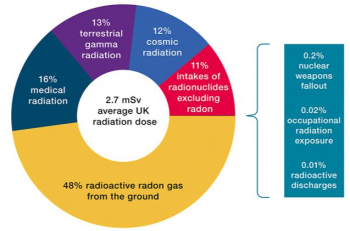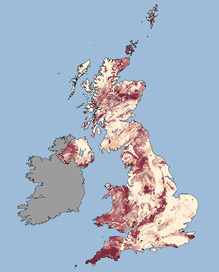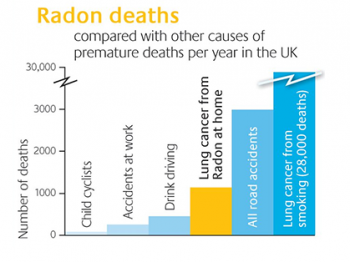Radon
The University of Sussex is undertaking Radon monitoring in several buildings around campus. This is part of due diligence activity to ensure suitable measures are in place to protect public health.
The table below shows the number of rooms that have been monitored and progress on the action plan. This will be updated monthly as part of the monitoring program.
|
Number of Radon Monitors placed |
Number of Radon Monitors where results have been returned |
Number of areas where access has been restricted |
|
28 |
27 |
0* |
*An initial Radon Monitor was placed in an underground storeroom that was being converted into a laboratory area. This area has been re-opened following improvements to the ventilation system.
Please see below for answer to frequently asked questions.
- What is radon?
-
Radon is a colourless, odourless, radioactive gas that occurs naturally in rocks and building materials. This type of radioactive material is commonly referred to as Naturally Occurring Radioactive Material (NORM). It is present worldwide with regional variations based on local geology.
- How widespread is radon?
-
Radon is the largest contributor to the radiation dose received by UK residents, see (figure 1) below. This varies by region based on local geology and is highest in Cornwall (see figure 2).
Figure 1
Figure 2
To some extent radon is present in both work and home environments but becomes a concern when above a defined action level.
Advice for what you can do about radon at home is available here from UK Health Security Agency (UKHSA).
- How does radon get there?
-
Radon is released from naturally occurring radioactive materials within the Earth’s crust, these materials release radon that percolates up out of the earth. When buildings are built, they can trap the radon in the building. It is for this reason that action levels are set above which steps must be taken to manage radon levels.
- What are the health affects from radon?
-
Radon contributes to the number of people that develop lung cancer over their lifetime.
Figure 3 shows the national statistics for radon deaths per year which are less than 1,000 people nationwide
Figure 3
- How is radon detected?
-
Radon detectors contain layers of specific plastics that are damaged by radiation. Once in place they should not be moved. Radon monitoring typically takes place over a three-month period. This is because radon levels vary over time, typically radon is released more at night and in winter months.
- Why hasn’t the University acted on radon before?
-
The UKHSA map of radon levels was updated in December 2022, prior to this update campus was shown as being at very low risk from radon. This map is very rarely updated.
One room was identified as being at particular risk of having high levels of radon during refurbishment work to change the use of the space from a store room to a laboratory space.
Now that this has been identified the University will be taking action on radon
- What is the University doing about radon?
-
The University is starting an extensive survey of buildings for radon. This will be managed by the Radiation Protection Officer with guidance from an external specialist. All radon monitoring results will be independently verified by an approved laboratory.
Initially the monitoring regime will focus on;
- Buildings occupied by the University that are in an area of elevated radon risk.
- Underground areas campus wide.
Any mounted radon monitor will be provided with signage about the purpose of the monitoring and links to additional information. The results of this will be used as part of a campus-wide radon risk assessment. Staff working in any area that may be identified as being above a radon action level will be contacted when this is identified.
- What should I do now?
-
No action is required on the part of staff or students. Should you need to provide information for the radon risk assessment you will be contacted by members of the Health & Safety Team.
Should an area you have worked in be identified as having high levels of radon you will be contacted by a member of the Health & Safety team. - A radon monitor has been placed in a location I work in, does this mean that radon is present in the room and what should I do?
-
Radon is present to some extent in most buildings. The purpose of a radon monitor is to see if the amount of radon present is above an action level. The presence of a radon monitor in a room does not indicate that the radon levels are too high in this space. It does mean that the University is performing due diligence checks in this space.
Please do not move or interfere with the radon monitor. If it is placed in a manner that affects your activities, please contact the Health & Safety Team.
- Why has one room been closed and not other nearby rooms?
-
Radon percolates out of the earth in unpredictable ways. The rate of radon release changes over time and can vary over small distances. Because of this it is not possible to predict which rooms might be affected.
- Where can I find out more about radon?
-
UKHSA provides a radon risk map that can be accessed here.
UKHSA provides guidance for homes here
Guidance for employers on how to manage radon is provided by the Health & Safety Executive (HSE)
The UK government approach is based on the International Atomic Energy Agency’s (IAEA) approach. The IAEA is an independent group of the United Nations.
The University professional body for radiation protection is the Association of University Radiation Protection Officer (AURPO)
Should you have any additional queries please contact the Health & Safety Team. and a response will be provided by the Universities Radiation Protection Officer
For official use only (recording detector locaions)
- H&S team radon detecotr login form (Official use only)
-
This form must only be filled out by authorised persons as part of the monitor program




